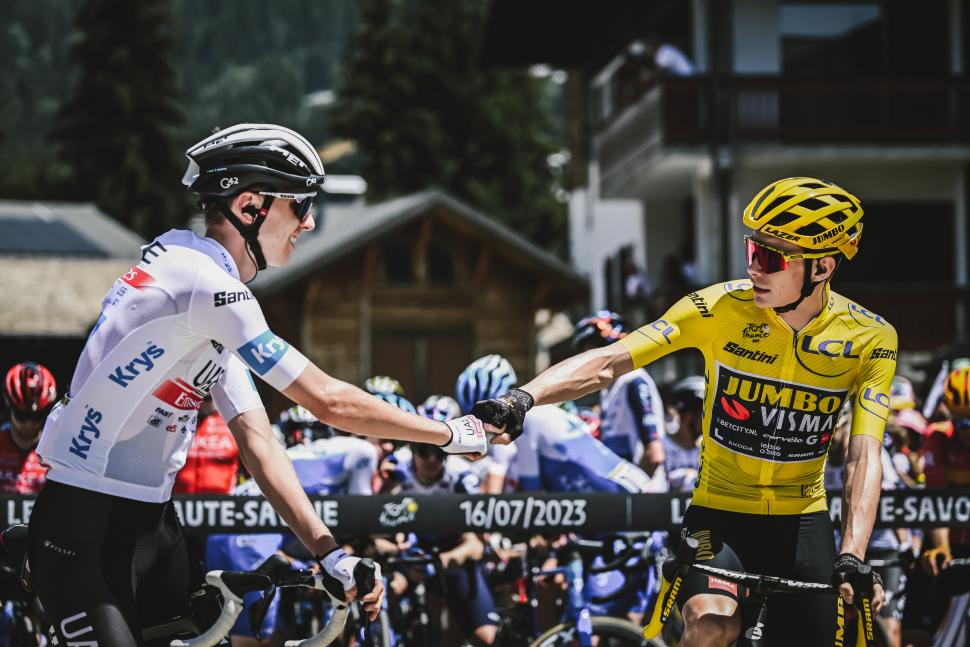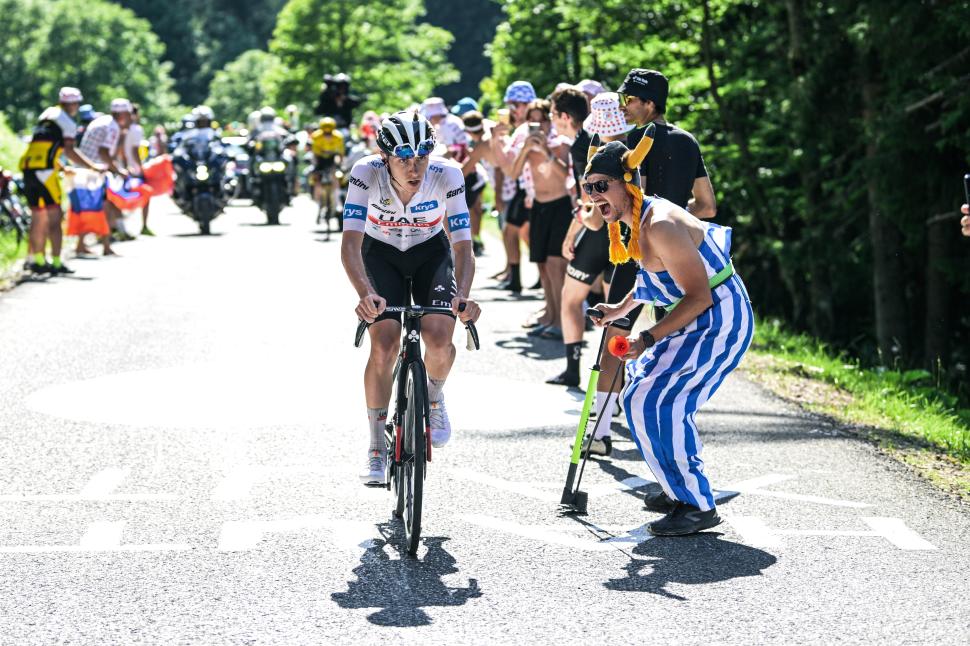- News
- Reviews
- Bikes
- Components
- Bar tape & grips
- Bottom brackets
- Brake & gear cables
- Brake & STI levers
- Brake pads & spares
- Brakes
- Cassettes & freewheels
- Chains
- Chainsets & chainrings
- Derailleurs - front
- Derailleurs - rear
- Forks
- Gear levers & shifters
- Groupsets
- Handlebars & extensions
- Headsets
- Hubs
- Inner tubes
- Pedals
- Quick releases & skewers
- Saddles
- Seatposts
- Stems
- Wheels
- Tyres
- Tubeless valves
- Accessories
- Accessories - misc
- Computer mounts
- Bags
- Bar ends
- Bike bags & cases
- Bottle cages
- Bottles
- Cameras
- Car racks
- Child seats
- Computers
- Glasses
- GPS units
- Helmets
- Lights - front
- Lights - rear
- Lights - sets
- Locks
- Mirrors
- Mudguards
- Racks
- Pumps & CO2 inflators
- Puncture kits
- Reflectives
- Smart watches
- Stands and racks
- Trailers
- Clothing
- Health, fitness and nutrition
- Tools and workshop
- Miscellaneous
- Buyers Guides
- Features
- Forum
- Recommends
- Podcast
news
 Tadej Pogačar and Jonas Vingegaard, stage 15, 2023 Tour de France (Alex Whitehead/SWpix.com)
Tadej Pogačar and Jonas Vingegaard, stage 15, 2023 Tour de France (Alex Whitehead/SWpix.com)Tour de France week two recap: Pogačar and Vingegaard on deuce as Tour for the ages set for final week tiebreaker
It’s perhaps fitting that on the same weekend the Wimbledon tennis finals took place in the hushed, reverential environs of Southwest London’s All England Club, amidst the altogether more spectacular and raucous atmosphere of the French Alps two of the finest male cyclists in the world served up a seemingly never-ending rally, filled with powerful baseline blasts, sumptuous volleys, and the occasional trick shot.
And after another week at a Tour de France overflowing with chaos, where advantages have been won and grimly clawed back, and where that delicately poised, tension-filled pendulum known as momentum has swung back-and-forth, Tadej Pogačar and Jonas Vingegaard remain serenely locked together at the top of the overall standings, the distance separating them less than that between the charging peloton and the outstretched arm of a selfie-snapping spectator.
(A.S.O./Pauline Ballet)
The summit of Mont Blanc, which towers over today’s finish at Saint-Gervais, is the subject of an ongoing, occasionally tense territorial dispute between France and Italy, one which has rumbled on since the French Revolution.
The dispute over who rightfully owns the yellow jersey at this year’s Tour de France feels, at times, like it may turn out to be even more protracted, and decided by even smaller margins than the ones fastidiously plotted by national mapping agencies.
Because, as the second week of one of the most compelling and chaotic Tours in recent memory draws to a close, only ten seconds separate Pogačar and Vingegaard, high above everyone else in the rarified air of their GC battle.
Of course, other Tours have been as tight, or even tighter, a fortnight in as this one. In 2008, only eight seconds separated Fränk Schleck, Cadel Evans, and the soon-to-be-disgraced Bernard Kohl after two weeks of racing.
But almost all of the major battlegrounds of that particular scandal-ridden Tour were characterised by cold war: only when Schleck’s CSC teammate Carlos Sastre, 49 seconds back in sixth on the second rest day, dropped a bomb on the race’s final major climb at Alpe d’Huez was anything more than a tenuous jab landed in the GC race.
(Alex Whitehead/SWpix.com)
Fast forward 15 years, and the CERA-era rules have been definitively tossed out the window. While the race’s relentless start in the Basque Country succeeded in deflating the tension that usually permeates the opening days of the Tour de France, the second week has been gleefully chaotic.
The hills and medium-sized mountains of stages 11 and 13 – the kind of transition days when the peloton of the 2010s would have opted for a nice, relaxing mid-Tour siesta – were instead relentless, all-action affairs, filled with tactical intrigue and dramatic, no holds barred racing.
Meanwhile, yesterday’s brutal trip to Morzine, and the equally brutal pace set by Jumbo-Visma throughout the day – preventing the breakaway from gaining even a minute – was unlike any mountain stage the Tour has ever seen.
Alongside the sublime, the last few days in the Alps and the Jura have also been laced with the ridiculous: from race neutralisations and self-absorbed, crash-causing ‘fans’ on the side of the road, to race motorbikes disturbing mountain-top sprints, the 2023 Tour really has had it all.
And amidst all that chaos, two things remain reassuringly constant: first, the seemingly passive acceptance that Jasper Philipsen is now the fastest sprinter in the world; and second, that Tadej Pogačar and Jonas Vingegaard are truly in a league of their own when it comes to grand tour racing.
(A.S.O./Charly Lopez)
In the context of that monumental, impossibly tight GC battle, the second week has been defined by one word: momentum. And momentum can be a tricky, constantly fluctuating phenomenon.
After the big, back-and-forth pendulum swings on the Marie Blanque and Cauterets in the Pyrenees, act two of the Tadej and Jonas show has been defined by marginal gains.
After Pogačar opened that narrow but telling gap on the Puy de Dôme last Sunday, the rope binding together the Slovenian and his Danish shadow has appeared steadily shorter over the course of the past week. Pogačar’s trademark sprint at the top of the Grand Colombier on Friday, after a stage-load of work from his UAE Team Emirates mates, clawed back another four seconds on the yellow jersey.
But it was the Jumbo-Visma man, with a little help from a wild crowd, stranded motos, and a barrier-less summit, who turned the tables on the Joux Plane the following day. Despite being briefly distanced on the final climb, by Morzine Vingegaard was in the money (or at least the bonuses) and the gap had inched back up by one solitary second to ten symbol-laden ones.
The momentum may not have been swinging back in the defending champion’s favour, but it was at least inching back towards the centre.
(Alex Whitehead/SWpix.com)
That sense of restored equilibrium was underlined on Sant-Gervais this afternoon, when the two Tour titans – like Poulidor and Anquetil, Lemond and Hinault before them – crossed the line side by side, barely a tyre between them (despite the efforts of both riders to create some kind of gap, and the unusual and head scratching policy of brinkmanship employed by Pogačar towards the finish).
Thanks to the tense, absorbing quality of the racing, the minimal gaps, and the inability to separate the leading duo in terms of strength (even their respective teams, for once, appear stubbornly matched), it’s little wonder this year’s Tour has drawn comparisons with the 1989 edition, the greatest grand tour of them all.
That 1989 Tour – the one with the eight second winning gap – was also one of constant, incremental momentum swings between Greg LeMond and Laurent Fignon, and tense, tight, dramatic racing, right up to that dramatic denouement on the Champs-Élysées.
The scene of this year’s decisive action may well prove to be next weekend in the Vosges, where over a century ago two superpowers slogged it out in an altogether grimmer battle of attrition and marginal gains.
As a Tour of continuous, probing jabs enters its final week, will it be Pogačar or Vingegaard who musters the strength to land a hammer blow?
After obtaining a PhD, lecturing, and hosting a history podcast at Queen’s University Belfast, Ryan joined road.cc in December 2021 and since then has kept the site’s readers and listeners informed and enthralled (well at least occasionally) on news, the live blog, and the road.cc Podcast. After boarding a wrong bus at the world championships and ruining a good pair of jeans at the cyclocross, he now serves as road.cc’s senior news writer. Before his foray into cycling journalism, he wallowed in the equally pitiless world of academia, where he wrote a book about Victorian politics and droned on about cycling and bikes to classes of bored students (while taking every chance he could get to talk about cycling in print or on the radio). He can be found riding his bike very slowly around the narrow, scenic country lanes of Co. Down.




Untitled
I came off my bike just before Christmas and broke my femur. The care was excellent and I'm back on the bike, albeit with more rehab to be done.
Are these actually 'hi-viz' - or just brights?...
That one was completely different though, it was a driver not a car as in the other 3. So 1 in 4 of the stories manage to follow reporting guidelines.
Absolutely they could have. Tarmac is a petroleum-based product and its surface can be very oily when it's newly laid. This is particularly the...
I'm glad the article went into more detail and cleared things up, the headline had me worried that some autonomous building had run rampant and...
Still here, just showing a few signs of wear and tear. Hopefully still serviceable for some years to come.
How can you know that you are "equally fearful" as "any female cyclist"? There is no possible way of quantifying such emotions and female cyclists...
I think it would be fairer to blame the moon - as in "my client is a loony".
Nice idea but Gloucestershire Constabulary are not interested as exemplified by this prvious NMOTD. Not only was there NFA for the close pass in...